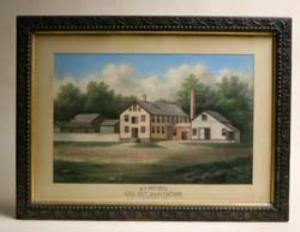In the early 1870s, Wilbur J. Squire (1837-1890) built his factory for the manufacture of gill nets in East Haddam. The factory was located in the part of East Haddam known as Goodspeed’s Landing and was a few hundred yards east of the present site of the Goodspeed Opera House. Mesh gill nets had openings of various sizes, depending upon the type of fish being caught. Such nets were usually set up parallel to the shore and fish would swim into the head-size openings in the net and attempt to swim through the openings. Unable to do so, they would attempt to back out and would be trapped by their gills.

A watercolor of “W. J. Squire’s Gill Net Manufactory, East Haddam, Conn.,” ca. 1880 – The Museum of Connecticut History
On May 21, 1878, Squire received a patent for what apparently were the first machines specifically designed to manufacture gill nets. Squire stated that the object of his machines was “the successful manufacture of nets by machinery” and he had, in essence, mechanized all the knot-tying operations used in making gill nets. Squire’s factory, consisting of two small buildings, appeared in F.W. Beers’ 1874 County Atlas of Middlesex, Connecticut, but it is unclear if he equipped it with his new machines. The watercolor shown here may have been commissioned to commemorate the building of the larger factory that appears in it. Squire died of consumption on February 6, 1890, at his sister’s in Colchester. His condition may have stemmed from his four years’ Civil War service as a Private in Co. G, 1st CT Heavy Artillery. In addition to his net-making machinery, Squire also patented a wrench in March 1876 and a wooden hoop fastener in July of that year.
Dave Corrigan is Curator for the Museum of Connecticut History
© Connecticut State Library. All rights reserved. This article is excerpted and originally appeared in The Connector, July 2008.
Note: ConnecticutHistory.org does not edit content originally published on another platform and therefore does not update any instances of outdated content or language.
Note: ConnecticutHistory.org does not edit content originally published on another platform and therefore does not update any instances of outdated content or language.









